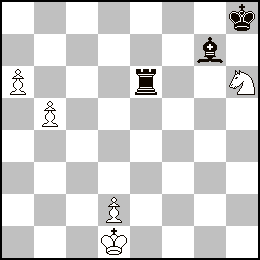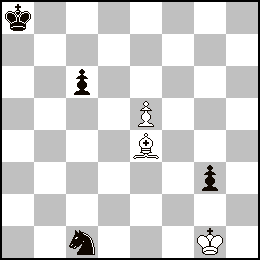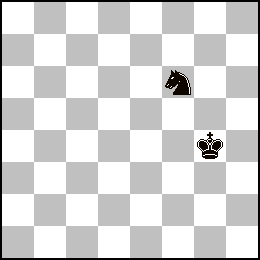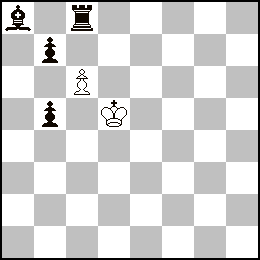A combination that starts well, but black has a defence on which it is necessary to take the sledgehammer blow
To follow, a very nice study with some traps
3 - White to play and win

W.: Kd1, Nh6, pa6, b5 and d2
B.: Kh8, Re6, Bg7
There is no possibility to switch the first and second white move
And a little exercise to finish the studies
4 - White to play and win

W.: Kg1, Be4, pe5
B.: Ka8, Nc1, pc6 and g3
5 - game of the day
1. e4 e5 2. Nf3 Nc6 3. d4 ed 4. Nxd4 Nf6 5. Nc3 Bb4 6. Nxc6 bc 7. Bd3 d5 8. ed Qe7+ 9. Qe2 QxQ+ 10. KxQ cd 11. Nd5 Kd8
(11. ... Ba5 12. Bf4 Kd8 13. Rhc1 Bd7 c4 Re8+ 15. Kf1 dc 16. dc Re4 is better for Black)
12. Rd1 c6 13. c3
(13. Nd4 is cleaner)
13. ... Re8+ 14. Kf1 Bf8
(a nice retirement with recycling planned on g7)
15. Nd4 Kc7
(a bit provocative, well in the habits of the black player, Bd7 was the most reasonable)
16. Bf4+ Kb6
(he puts a layer the bugger, 16. ... Bd6, 17. Bxd6+ Kxd6 18. b4 a5 19. a4 Ne4 20. Nxc6 Nxc3 21. Rdc1 ab and everything seems to be in order)
17. a4 a5 18. b4 ab 19 a5+ Kb7
(19. ... Rxa5 20. Rxa5 Kxa5 21. Bc7+)
20. cb Ne4
(20. ... Bxb4 21. Rcb1 c5 22. Bd6 is bleeding but 20. ... Bd7 21. b5 c5 22. b6 c4 23. Bf5 BxB 24. NxB c3 25. Rdc1 Ne4 26.
f3 Nd2+ 27. Bxd2 cd 28. Rcb1 g6 29. Nd4 Rxa5 30. Rxa5 Bb4 holds up)
21. Nxc6 ?
(White's player is a sacrifice player, there was better: 21. a6+ Kb6 22. Rdc1 Bd7 23. Be3 Bxb4 24. Rab1 c5 25.
Rxb4+ cb 26. Nb3+ allows to conclude)
21. ... g5! 22. Bxe4 Rxe4 23. Nd8+ Ka6 24. Bxg5 Be6 25. Nc6
(25. Nxe6 fe 26. Rdc1 Kb5 27. Rc7 Bxb4 28. Rb1 and it's a little tight in the thong for black)
25. ... Bg7 26. Rac1 Rc4 27. Be3 Kb5 28. Na7+ Kxb4
(28. ... Ka4 29. Rb1)
29. Bb6
(29. Rb1+ Ka3 30. Rd2 Rxa7 31. Bxa7 Bc3 and the Bishops begin to talk)
29. ... Rc3?
(29. ... Bf5 or Bb2 were still better)
30. Rb1+ Rb3 31. Nc6+ Ka4 32. Bd4 Bxd4 33. Nxd4 Ra6 34. Ra1 Kb4 35. Ke2 Bd7 37. Nc2+?
(Zeitnot, 37. Kd3 or Ke3 would have been better)
37. ... Kc3 38. Ne3 Bb5+ 39. Ke1 d4 40 Rc1+ Kd3 41. Rd1+ and draw was agreed.
A nice old-fashioned fight.
To finish your brain, a bit of Peter Harris seen during the meal.
Fasten your seatbelts.
6 - serial h#6 ultra-patrol, opponent's pawn sentinels , Einstein Chess (it's enough ?)
serial helpmate 6 moves : black plays 6 moves in a row and white checkmates in 1 move (or rather half a move)
Ultra-patrol : for any movement, it must be controlled by a piece of its own side
opponent's pawn sentinels : any moving piece deflates an opponent's pawn on the starting square of the move (pawn movements are not affected)
Einstein Chess : according to the p-N-B-R-Q cycle, pieces progress or regress depending on whether or not they capture

W.:
B.: Kg4, Nf6
Yes, you are not dreaming, there is no white piece, they will come with the successive defecations.
In the same vein and by the same author.
7 - serial hs#5 ultra-patrol opponent's pawn sentinels Andernach (the belt withstood the frontal impact ?) 2 solutions (that's all)
serial hs#5 coups : black plays 5 moves in a row after which white plays and forces black to mate in 1 move
Andernach : when a piece is capturing, it changes colour
2 solutions : there are 2 distinct ways to satisfy the statement

W.: Kd5, pc6
B.: Rc8, Ba8, pb7 and b5
To help you, there are only 2 possible black moves 1. b6 and 1. bxc6 (=pbc6)
It does not seem that there is any problem of legality of the position thanks to the Andernach characteristic
That will be all for today with an unusual Harrisian density.
"Harris sonne fort" (for friend Pascal Depyl) said the clerk who for the occasion was dressed in the Indiana hat.
Of course, friend Guy presented some of his work, and you can only enjoy it if you subscribe to the 50 problem magazines in which he officiates!
I hope you are still alive after these alien statements and wish you all a good read.
Yours sincerely
Le greffier
Add a comment